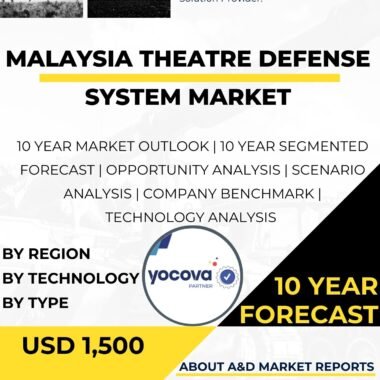Description
The United States Theatre Defense System represents a critical component of the nation’s overall missile defense architecture, providing protection against ballistic missile threats within specific theaters of operation. Developed to safeguard U.S. forces, allies, and key assets abroad, the theatre defense system is designed to counter regional missile threats and deter potential adversaries from aggression. This intricate network of integrated systems employs a layered approach, incorporating various interceptors, sensors, and command and control elements to ensure comprehensive and effective defense.
The origins of the U.S. Theatre Defense System can be traced back to the Cold War era when the threat of ballistic missile attacks on U.S. and allied forces was a paramount concern. During this time, the development of theatre ballistic missile defense (TBMD) gained momentum, with the primary focus on countering short and medium-range ballistic missiles.
One of the earliest components of the Theatre Defense System was the Patriot missile system, which was first introduced in the 1980s. Initially designed as an air defense system, the Patriot was adapted to counter ballistic missile threats during the Gulf War in 1991. Its evolution from an anti-aircraft system to a multi-mission missile defense system marked a significant milestone in the development of theatre missile defense capabilities.
The Ballistic Missile Defense Organization (BMDO), later known as the Missile Defense Agency (MDA), played a crucial role in spearheading the research, development, and deployment of the U.S. Theatre Defense System. The BMDO’s mission was to develop effective ballistic missile defenses for all phases of flight, including boost, midcourse, and terminal phases.
The evolution of the U.S. Theatre Defense System gained further momentum in the early 2000s when the focus shifted to enhancing the capability to defend against long-range ballistic missiles. The Ground-based Midcourse Defense (GMD) system, a key element of the overall missile defense architecture, was developed to protect the United States and its territories from intercontinental ballistic missile (ICBM) threats.
The GMD system utilizes a network of ground-based interceptors, located at strategic sites in the United States, to detect and intercept incoming ballistic missiles during the midcourse phase of flight. The system’s long-range radars and sophisticated sensors work in concert to track and discriminate between threats and decoys, ensuring the most accurate targeting and intercept of incoming warheads.
Alongside the GMD system, the Aegis Ballistic Missile Defense (BMD) system represents another critical component of the U.S. Theatre Defense System. Based on the Aegis combat system, which was originally developed for naval air defense, the Aegis BMD system has been adapted to provide regional ballistic missile defense capabilities.
The Aegis BMD system equips U.S. Navy cruisers and destroyers with advanced radar and interceptor technologies, enabling them to detect and engage short to intermediate-range ballistic missiles in the midcourse and terminal phases of flight. The system’s Standard Missile-3 (SM-3) interceptors have proven highly effective in multiple successful intercept tests and operational deployments.
As threats continue to evolve, the U.S. Theatre Defense System remains adaptable and agile. One notable development is the deployment of the Terminal High Altitude Area Defense (THAAD) system, a highly mobile, rapidly deployable missile defense system designed to counter short and medium-range ballistic missiles during the terminal phase of flight.
The THAAD system employs powerful radar and multiple launchers to detect, track, and engage incoming missiles. Its versatility makes it well-suited for deployment in various theatres of operation, offering an additional layer of defense for critical assets and population centers.
Furthermore, the United States has collaborated with allied nations to enhance theatre missile defense capabilities. Cooperative efforts, such as the integration of the Aegis BMD system on Japanese and South Korean destroyers, foster greater regional security cooperation and mutual defense against common threats.
The integration of space-based assets has also strengthened the U.S. Theatre Defense System. Space-based sensors provide critical early warning and tracking data, enhancing the overall accuracy and effectiveness of the missile defense architecture.
Space-based tracking and surveillance capabilities offer real-time information on ballistic missile launches, providing U.S. and allied forces with sufficient time to evaluate threats, assess potential impacts, and take appropriate defensive measures.
While the U.S. Theatre Defense System has made significant strides, challenges persist. The proliferation of advanced missile technologies by potential adversaries poses a dynamic and evolving threat environment. Emerging hypersonic weapons, maneuverable re-entry vehicles, and countermeasures challenge the effectiveness of existing defense systems.
The U.S. military continues to invest in research and development to address these challenges and maintain the competitive edge in missile defense. The development of new interceptor technologies, such as the Next Generation Interceptor (NGI), seeks to enhance the capability to defeat advanced and evolving threats.
Additionally, the integration of artificial intelligence, machine learning, and advanced data processing capabilities into missile defense systems holds promise in enhancing the speed and accuracy of threat detection and response.
Moreover, the U.S. Theatre Defense System is part of a broader approach to missile defense, which includes global strategic defense against intercontinental threats. The integration of regional and national missile defense components within a layered approach ensures comprehensive coverage and redundancy, reducing the probability of successful ballistic missile attacks.
In conclusion, the U.S. Theatre Defense System plays a pivotal role in safeguarding U.S. forces, allies, and key assets from regional ballistic missile threats. Developed over decades of research, development, and testing, this multi-layered defense architecture integrates various interceptors, sensors, and command and control elements to provide comprehensive protection. The deployment of the GMD system, Aegis BMD system, THAAD, and cooperative efforts with allied nations underscores the commitment of the United States to strengthening regional security and stability. While challenges remain, continuous research and development efforts strive to keep the U.S. Theatre Defense System at the forefront of missile defense capabilities, ensuring readiness and deterrence against potential adversaries.




